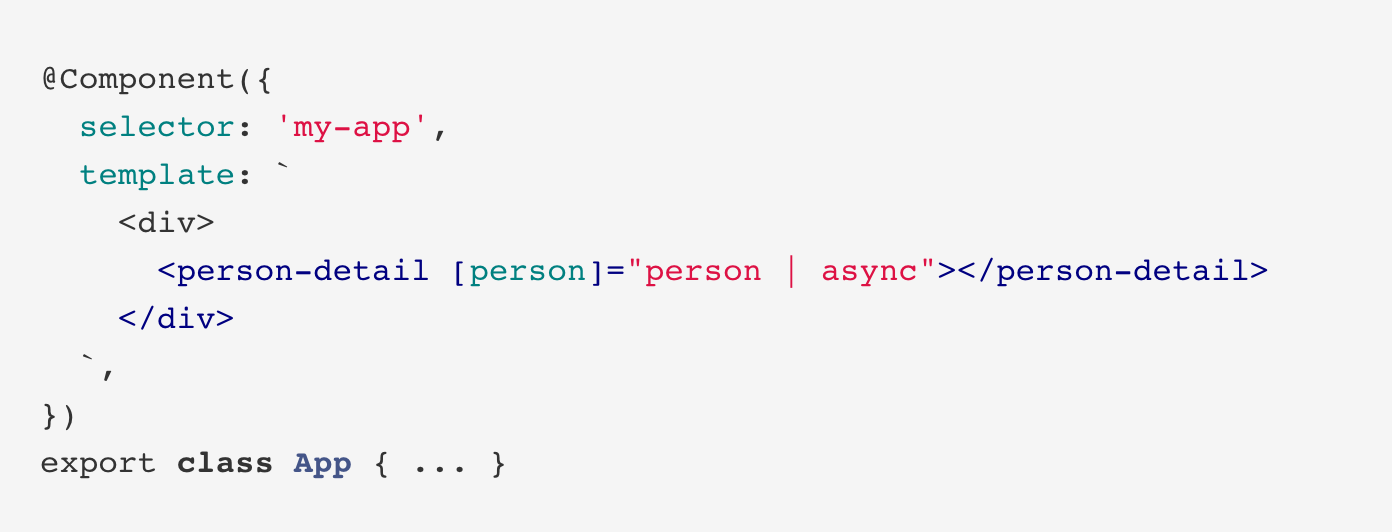Safe Navigation Operator, RxJS and Async Pipe tinkering


RxJS? Safe Navigation operator? Async pipes? Not sure what I’m talking about? In this article I’d like to explore some cool combination of Http, RxJS and Async Pipes.
Contents are based on Angular version >= 2
If you already played with Angular, I’m pretty sure you came across RxJS. It plays a big role in Angular, especially in Http, Forms, Async Pipes, Routing and also in application architecture patterns like ngrx/store.
Get started with reactive programming with this introductory video
Rob Wormald’s (Angular Developer Evangelist @ Google) showed some impressive usage of RxJS with Angular during his talk at NgEurope on “Angular & RxJS”. Some involved using the Safe Navigation Operator and how it can be replaced via async pipes.
Our task
Let’s assume we have the following data returned by some server API.
{
"name": "Juri Strumpflohner",
"status": "Currently coding on a screencast",
"website": {
"url": "http://juristr.com",
"name": "juristr.com"
},
"twitter": {
"url": "https://twitter.com/juristr",
"name": "@juristr"
}
}We want to create a component that displays the details of this person by using the data it gets passed. Something like this:
import {Component, Input} from '@angular/core'
@Component({
selector: 'person-detail',
template: `
<div>
{% raw %}Name: {{ person.name }}<br/>
Twitter: {{ person.twitter.name }}
</div>
`,
})
export class PeopleComponent {
@Input() person;
}Option 1: Pass in a person object
So our first option is to simply get the data in our parent component via the Angular http service.
this.http
.get('person.json')
.map(res => res.json())
.subscribe(data => {
this.person = data
});And then pass the person into our <person-detail> component.
import { Subject } from 'rxjs/Subscription';
@Component({
selector: 'my-app',
template: `
<div>
<person-detail [person]="person"></person-detail>
</div>
`,
})
export class App implements OnInit, OnDestroy {
subscription: Subscription;
person;
constructor(private http:Http) { }
ngOnInit() {
this.subscription =
this.http
.get('person.json')
.map(res => res.json())
.subscribe(data => {
this.person = data
});
}
ngOnDestroy() {
// unsubscribe to avoid memory leaks
this.subscription.unsubscribe();
}
}But wait. This won’t work. Look at our PersonDetailComponent template:
<div>
Name: {% raw %}{{ person.name }}<br/>
Twitter: {% raw %}{{ person.twitter.name }}
</div>We access name and twitter.name on person, however the latter won’t be defined when our component is instantiated. After all, we first need to call the server to get the data. So this results in a runtime exception.
Error: Uncaught (in promise): Error: Error in ./PersonDetailComponent class PersonDetailComponent - inline template:1:9 caused by: Cannot read property 'name' of undefined
TypeError: Cannot read property 'name' of undefined
at _View_PersonDetailComponent0.detectChangesInternal (VM3423 component.ngfactory.js:45)
at _View_PersonDetailComponent0.AppView.detectChanges (core.umd.js:9305)
at _View_PersonDetailComponent0.DebugAppView.detectChanges (core.umd.js:9410)
at _View_App0.AppView.detectViewChildrenChanges (core.umd.js:9331)
...Safe Navigation Operator to the rescue
By using the Safe Navigation Operator (?) we can change our PersonDetailComponent template to this:
<div>
Name: {% raw %}{{ person?.name }}<br/>
Twitter: {% raw %}{{ person?.twitter.name }}
</div>Simply speaking, this special operator allows us to bind data to our template that will be available later. When the data becomes available, values evaluated and rebound via change tracking.
Try yourself
Option 2: Using async pipes
First of all, Pipes are what you may know as “filters” from Angular 1.x. Just as the original Unix pipes, they allow you to pass data through it and do something with it, such as transform the data for instance. Here’s an example of how a pipe that formats a date value could look like:
{{ someDateValue | format: 'dd/MM/yyyy' }}There’s a special, built-in pipe, called async. The async pipe accepts an RxJs Observable object and does the entire subscription and handling for us.
So we can basically transform our original example to this:
@Component(...)
export class App {
person;
constructor(private http:Http) { }
ngOnInit() {
this.person = this.http
.get('person.json')
.map(res => res.json());
}
}Note how there is no more subscribe(...) part but instead we directly assign the returned Observable to our person variable. But who does the subscription then?? It’s the async pipe.
Variant 1: Async pipe in the detail component
Our parent component (or smart component) remains unchanged, while our detail (or dumb component) displaying the person must be changed. Given the passed @Input person is an Observable we need to wrap it with the async pipe: (person | async)?.name.
@Component({
selector: 'person-detail',
template: `
<div>
Name: {{ (person | async)?.name }}<br/>
Twitter: {{ (person | async)?.twitter.name }}
</div>
`,
})
export class PersonDetailComponent {
@Input() person;
...
}Try it out yourself.
Variant 2: Async pipe in the parent component
I’m not that big of a fan of the previous variant, where our dumb component visualizing the detail of our person needs to know about the async nature of it’s input. That creates coupling to the outside world. Within our dumb component I don’t want to know where my data comes from; its responsibility is mainly to visualize the input.
So we can do better. Rather than using the async pipe in our dumb component, let’s move it out to our parent.
@Component({
selector: 'my-app',
template: `
<div>
<person-detail [person]="person | async"></person-detail>
</div>
`,
})
export class App { ... }Our dumb component’s template can be left without the async wrapper.
This is much nicer in my opinion. Also, note that a big advantage of using the built-in async pipe is that we don’t have to deal with the Observable subscription/unsubscription any more by ourself.
Safe Navigation Operator vs. default values
There’s one thing left which we would change as well. Our dumb component still uses the “safe navigation operator”:
import {Component, NgModule, Input} from '@angular/core'
@Component({
selector: 'person-detail',
template: `
<div>
Name: {{ person?.name }}<br/>
Twitter: {{ person?.twitter.name }}
</div>
`,
})
export class PersonDetailComponent {
@Input() person;
}Obviously we can totally live with that, but there’s another options as well by setting some default values on our @Input. Let’s explore.
Version 2:
Don’t use the safe navigation operator, but rather do some default initialization of your @Input object.
import {Component, NgModule, Input} from '@angular/core'
@Component({
selector: 'person-detail',
template: `
<div>
Name: {{ person.name }}<br/>
Twitter: {{ person.twitter.name }}
</div>
`,
})
export class PersonDetailComponent {
@Input() person;
ngOnInit() {
// set default init -> MUST BE IN ngOnInit
this.person = { twitter: {} };
}
}Note, for some (to me) unknown reason, this has to be done in the ngOnInit lifecycle event, otherwise it doesn’t work.
Try yourself
Option 3: Lists
Async pipes work even more nicely. Our detail component gets the data and doesn’t have to neither use the safe navigation operator, nor default values. The reason is that our *ngFor serves as a guard until the data arrives.
import {Component, NgModule, Input} from '@angular/core'
@Component({
selector: 'my-people',
template: `
<div *ngFor="let person of people">
{{ person.twitter.name }}
</div>
`,
})
export class PeopleComponent {
@Input() people;
constructor() {
}
}Conclusion
The async pipe is a really powerful operator.
- it deeply integrates with RxJS Observables and the Angular change detection mechanism.
- it handles Observable subscriptions transparently for us (in an optimized way)
- it makes our async code look as if was synchronous
Don’t forget to check out Rob’s talk.
Related articles
Learn about hot vs cold observables and how .share() can reduce your network load.
Many thanks to Brecht Billiet and Dominic Elm for reviewing this article.